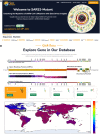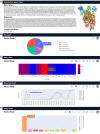SARS2Mutant: SARS-CoV-2 amino-acid mutation atlas database
- PMID: 37101659
- PMCID: PMC10124966
- DOI: 10.1093/nargab/lqad037
SARS2Mutant: SARS-CoV-2 amino-acid mutation atlas database
Abstract
The coronavirus disease 19 (COVID-19) is a highly pathogenic viral infection of the novel severe acute respiratory syndrome coronavirus 2 (SARS-CoV-2), resulted in the global pandemic of 2020. A lack of therapeutic and preventive strategies has quickly posed significant threats to world health. A comprehensive understanding of SARS-CoV-2 evolution and natural selection, how it impacts host interaction, and phenotype symptoms is vital to develop effective strategies against the virus. The SARS2Mutant database (http://sars2mutant.com/) was developed to provide valuable insights based on millions of high-quality, high-coverage SARS-CoV-2 complete protein sequences. Users of this database have the ability to search for information on three amino acid substitution mutation strategies based on gene name, geographical zone, or comparative analysis. Each strategy is presented in five distinct formats which includes: (i) mutated sample frequencies, (ii) heat maps of mutated amino acid positions, (iii) mutation survivals, (iv) natural selections and (v) details of substituted amino acids, including their names, positions, and frequencies. GISAID is a primary database of genomics sequencies of influenza viruses updated daily. SARS2Mutant is a secondary database developed to discover mutation and conserved regions from the primary data to assist with design for targeted vaccine, primer, and drug discoveries.
© The Author(s) 2023. Published by Oxford University Press on behalf of NAR Genomics and Bioinformatics.
Figures





Similar articles
-
Emerging SARS-CoV-2 mutation hot spots include a novel RNA-dependent-RNA polymerase variant.J Transl Med. 2020 Apr 22;18(1):179. doi: 10.1186/s12967-020-02344-6. J Transl Med. 2020. PMID: 32321524 Free PMC article.
-
COVID-19 CG enables SARS-CoV-2 mutation and lineage tracking by locations and dates of interest.Elife. 2021 Feb 23;10:e63409. doi: 10.7554/eLife.63409. Elife. 2021. PMID: 33620031 Free PMC article.
-
Current status of antivirals and druggable targets of SARS CoV-2 and other human pathogenic coronaviruses.Drug Resist Updat. 2020 Dec;53:100721. doi: 10.1016/j.drup.2020.100721. Epub 2020 Aug 26. Drug Resist Updat. 2020. PMID: 33132205 Free PMC article. Review.
-
Genome-wide association analysis of COVID-19 mortality risk in SARS-CoV-2 genomes identifies mutation in the SARS-CoV-2 spike protein that colocalizes with P.1 of the Brazilian strain.Genet Epidemiol. 2021 Oct;45(7):685-693. doi: 10.1002/gepi.22421. Epub 2021 Jun 22. Genet Epidemiol. 2021. PMID: 34159627 Free PMC article.
-
Identification of Novel Candidate Epitopes on SARS-CoV-2 Proteins for South America: A Review of HLA Frequencies by Country.Front Immunol. 2020 Sep 3;11:2008. doi: 10.3389/fimmu.2020.02008. eCollection 2020. Front Immunol. 2020. PMID: 33013857 Free PMC article. Review.
Cited by
-
Comparative Atlas of SARS-CoV-2 Substitution Mutations: A Focus on Iranian Strains Amidst Global Trends.Viruses. 2024 Aug 20;16(8):1331. doi: 10.3390/v16081331. Viruses. 2024. PMID: 39205305 Free PMC article.
-
Multiple Lines of Evidence Support 199 SARS-CoV-2 Positively Selected Amino Acid Sites.Int J Mol Sci. 2024 Feb 19;25(4):2428. doi: 10.3390/ijms25042428. Int J Mol Sci. 2024. PMID: 38397104 Free PMC article.
-
The First Geographic Identification by Country of Sustainable Mutations of SARS-COV2 Sequence Samples: Worldwide Natural Selection Trends.bioRxiv [Preprint]. 2022 Jul 19:2022.07.18.500565. doi: 10.1101/2022.07.18.500565. bioRxiv. 2022. PMID: 35898341 Free PMC article. Preprint.
-
Applying the digital data and the bioinformatics tools in SARS-CoV-2 research.Comput Struct Biotechnol J. 2023 Oct 1;21:4697-4705. doi: 10.1016/j.csbj.2023.09.044. eCollection 2023. Comput Struct Biotechnol J. 2023. PMID: 37841328 Free PMC article. Review.
-
Intersecting SARS-CoV-2 spike mutations and global vaccine efficacy against COVID-19.Front Immunol. 2025 Mar 7;16:1435873. doi: 10.3389/fimmu.2025.1435873. eCollection 2025. Front Immunol. 2025. PMID: 40124365 Free PMC article.
References
Grants and funding
LinkOut - more resources
Full Text Sources
Molecular Biology Databases
Miscellaneous

